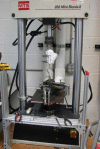Biomechanical Properties of Small-Size Hamstring Autografts
- PMID: 32714668
- PMCID: PMC7374285
- DOI: 10.7759/cureus.8728
Biomechanical Properties of Small-Size Hamstring Autografts
Abstract
Purpose To evaluate small-size hamstring (HS) autografts for biomechanical properties and determine a threshold diameter necessary for appropriate reconstruction. Methods In a controlled laboratory setting, biomechanical testing was performed upon 15 hamstring autografts. The grafts were divided into three groups by diameter, with five grafts each at diameter sizes of 6, 7, and 8 mm. Testing of the specimens was performed using an MTS 858 (Materials Testing System, Eden Prairie, MN). We determined load to failure by looking at the maximum load as well as the stiffness of the graft. Statistical analysis was performed via analysis of variance (ANOVA) testing with Tukey's post-hoc test and P-values set at 0.05. Results There was a significant difference in ultimate tensile strength for the different size grafts: 1990 +/- 302.42 N for 6 mm grafts (n=5), 2179 +/- 685.36 N for the 7 mm grafts (n=5), and 3074 +/- 781 N for 8 mm grafts (n=5). This was statistically significant for the group overall (p=0.039), as well as between the 6 mm and 8 mm grafts (p=0.044). Graft stiffness for the 6 mm grafts was 317 +/- 85 N (n=5), 288.6 +/- 66 for 7 mm grafts (n=5), and 428.053 +/- 83 for 8 mm grafts (n=5). This achieved statistical significance for the group overall (p =0.037) as well as between the 8 mm and 7 mm grafts. Conclusions The biomechanical data presented here demonstrate that graft diameter is highly correlated with ultimate tensile strength and stiffness. Clinical relevance When viewing this biomechanical data in conjunction with prior clinical data, consideration should be given for the supplementation of an HS autograft as the size decreases below 8 mm.
Keywords: acl repair; biomechanical properties; hamstring autografts.
Copyright © 2020, Haupt et al.
Conflict of interest statement
The authors have declared financial relationships, which are detailed in the next section.
Figures




References
-
- An illustrated history of anterior cruciate ligament surgery. McCulloch PC, Lattermann C, Boland AL, Bach BR Jr. J Knee Surg. 2007;20:95–104. - PubMed
-
- Revision anterior cruciate ligament reconstruction with nonirradiated fresh-frozen patellar tendon allograft. Fox JA, Pierce M, Bojchuk J, Hayden J, Bush-Joseph CA, Bach BR Jr. Arthroscopy. 2004;20:787–794. - PubMed
-
- Current concepts review: revision anterior cruciate ligament reconstruction. George MS, Dunn WR, Spindler KP. Am J Sports Med. 2006;34:2026–2037. - PubMed
-
- Revision anterior cruciate surgery with use of bone-patellar tendon-bone autogenous grafts. Noyes FR, Barber-Westin SD. J Bone Joint Surg Am. 2001;83:1131–1143. - PubMed
-
- Incidence of subsequent injury to either knee within 5 years after anterior cruciate ligament reconstruction with patellar tendon autograft. Shelbourne KD, Gray T, Haro M. Am J Sports Med. 2009;37:246–251. - PubMed
LinkOut - more resources
Full Text Sources
Other Literature Sources
